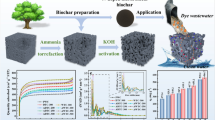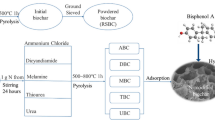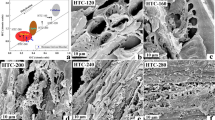Abstract
Metal-free biochar to activate persulfate and degrade organic contaminants has attracted great attention in advanced oxidation processes, while the role of biochar adsorption in the activation and oxidative decomposition process still needed to be further clarified. In this study, nitrogen-doped porous biochar derived from a waste litchi branch was prepared as a peroxydisulfate (PDS) activator for bisphenol A (BPA) degradation, in which the regulation behavior of biochar adsorption was evaluated on the basis of phase distribution and PDS activation mechanism. N-doped biochar obtained at 800 °C with urea and sodium bicarbonate added presented a high specific surface area (821 m2/g), abundant nanopores, and a graphitic structure, and showed the best adsorption capacity and catalytic activity toward BPA. At a dosage of 0.15 g/L NBC-800, 95% BPA can be completely degraded within 60 min with an apparent rate constant (kobs) of 0.0483 min−1. The identified active sites and reactive oxygen species as well as electrochemical tests suggested that both free radicals O2•− and •OH and nonradical pathways including 1O2 originated from C = O and surface electron-transfer mechanisms were involved in BPA decomposition. The experiments and activation mechanisms all confirmed that BPA adsorption on the NBC-800 surface was an extremely crucial step for BPA oxidative degradation.







Similar content being viewed by others
Data availability
The original data can be obtained from the authors upon reasonable request. And the supplementary material related to this article can be found online.
References
Ahmad A, Gu XG, Li L, Lv SG, Xu YS, Guo XH (2015) Efficient degradation of trichloroethylene in water using persulfate activated by reduced graphene oxide-iron nanocomposite. Environ Sci Pollut Res 22(22):17876–17885
Ahn S, Peterson TD, Righter J, Miles DM, Tratnyek PG (2013) Disinfection of ballast water with iron activated persulfate. Environ Sci Technol 47(20):11717
Almanassra IW, Mckay G, Kochkodan V, Atieh MA, Al-Ansari T (2021) A state of the art review on phosphate removal from water by biochars. Chem Eng J 409
Anipsitakis GP, Dionysiou DD (2004) Radical generation by the interaction of transition metals with common oxidants. Environ Sci Technol 38(13):3705
Brown RA, Kercher AK, Nguyen TH, Nagle DC, Ball WP (2006) Production and characterization of synthetic wood chars for use as surrogates for natural sorbents. Org Geochem 37(3):321
Buxton GV, Greenstock CL, Helman WP, Ross AB (1988) Critical review of rate constants for reactions of hydrated electrons, hydrogen atoms and hydroxyl radicals (⋅OH/⋅O− in aqueous solution. J Phys Chem Ref Data 17(2):513–886
Cao W, Luo Y, Cai X, Wang S, Hu C, Lyu L (2021) π-π conjugation driving peroxymonosulfate activation for pollutant elimination over metal-free graphitized polyimide surface. J Hazard Mater 412:125191
Chen J, Yu X, Li C, Tang X, Sun Y (2020) Removal of tetracycline via the synergistic effect of biochar adsorption and enhanced activation of persulfate. Chem Eng J 382
Cheng X, Guo HG, Zhang YL, Wu X, Liu Y (2017) Non-photochemical production of singlet oxygen via activation of persulfate by carbon nanotubes. Water Res 113:80–88
Chi H, Wang Z, He X, Zhang J, Wang D, Ma J (2019) Activation of peroxymonosulfate system by copper-based catalyst for degradation of naproxen: mechanisms and pathways. Chemosphere 228:54–64
Drzewicz P, Perez-Estrada L, Alpatova A, Martin JW, Gamal El-Din M (2012) Impact of peroxydisulfate in the presence of zero valent iron on the oxidation of cyclohexanoic acid and naphthenic acids from oil sands process-affected water. Environ Sci Technol 46(16):8984
Duan X, Sun H, Kang J, Wang Y, Indrawirawan S, Wang S (2015) Insights into heterogeneous catalysis of persulfate activation on dimensional-structured nanocarbons. ACS Catal 5(8):4629
Duan XG, Ao ZM, Zhou L, Sun HQ, Wang GX, Wang SB (2016) Occurrence of radical and nonradical pathways from carbocatalysts for aqueous and nonaqueous catalytic oxidation. Applied Catalysis B-Environmental 188:98–105
Duan XG, Ao ZM, Zhang HY, Saunders M, Sun HQ, Shao ZP, Wang SB (2018) Nanodiamonds in sp(2)/sp(3) configuration for radical to nonradical oxidation: core-shell layer dependence. Applied Catalysis B-Environmental 222:176–181
Fang G, Liu C, Gao J, Dionysiou DD, Zhou D (2015) Manipulation of persistent free radicals in biochar to activate persulfate for contaminant degradation. Environ Sci Technol 49(9):5645
Ferrari AC, Robertson J (2000) Interpretation of Raman spectra of disordered and amorphous carbon. Phys Rev B 61(20):14095–14107
He J, Xiao Y, Tang J, Chen H, Sun H (2019) Persulfate activation with sawdust biochar in aqueous solution by enhanced electron donor-transfer effect. Sci Total Environ 690:768–777
Hu C-Y, Hou Y-Z, Lin Y-L, Deng Y-G, Hua S-J, Du Y-F, Chen C-W, Wu C-H (2020) Investigation of iohexol degradation kinetics by using heat-activated persulfate. Chem Eng J 379:122403
Huggins TM, Pietron JJ, Wang HM, Ren ZJ, Biffinger JC (2015) Graphitic biochar as a cathode electrocatalyst support for microbial fuel cells. Biores Technol 195:147–153
Indrawirawan S, Sun HQ, Duan XG, Wang SB (2015) Nanocarbons in different structural dimensions (0–3D) for phenol adsorption and metal-free catalytic oxidation. Applied Catalysis B-Environmental 179:352–362
Jiang L, Zhang Y, Zhou M, Liang L, Li K (2018) Oxidation of rhodamine B by persulfate activated with porous carbon aerogel through a non-radical mechanism. J Hazard Mater 358:53–61
Kemmou L, Frontistis Z, Vakros J, Manariotis ID, Mantzavinos D (2018) Degradation of antibiotic sulfamethoxazole by biochar-activated persulfate: factors affecting the activation and degradation processes. Catal Today 313:128–133
Kim D-G, Ko S-O (2020) Effects of thermal modification of a biochar on persulfate activation and mechanisms of catalytic degradation of a pharmaceutical. Chem Eng J 399
Lee H, Kim HI, Weon S, Choi W, Hwang YS, Seo J, Lee C, Kim JH (2016a) Activation of Persulfates by graphitized nanodiamonds for removal of organic compounds. Environ Sci Technol 50(18):10134–10142
Li Y, Xing B, Wang X, Wang K, Zhu L, Wang S (2019) Nitrogen-doped hierarchical porous biochar derived from corn stalks for phenol-enhanced adsorption. Energy Fuels 33(12):12459–12468
Lian F, Xing B (2017) Black carbon (biochar) in water/soil environments: molecular structure, sorption, stability, and potential risk. Environ Sci Technol 51(23):13517–13532
Lian F, Cui G, Liu Z, Duo L, Zhang G, Xing B (2016) One-step synthesis of a novel N-doped microporous biochar derived from crop straws with high dye adsorption capacity. J Environ Manage 176:61–68
Lin K-YA, Zhang Z-Y, Wi-Afedzi T (2018) Sulfur-doped carbon nitride as a non-metal heterogeneous catalyst for sulfate radical-based advanced oxidation processes in the absence of light irradiation. Journal of Water Process Engineering 24:83–89
Liu H, Liu Y, Tang L, Wang J, Yu J, Zhang H, Yu M, Zou J, Xie Q (2020a) Egg shell biochar-based green catalysts for the removal of organic pollutants by activating persulfate. Sci Total Environ 745:141095
Liu JG, Jiang SJ, Chen DD, Dai GL, Wei DY, Shu YH (2020b) Activation of persulfate with biochar for degradation of bisphenol A in soil. Chem Eng J 381
Long Y, Bu S, Huang Y, Shao Y, Xiao L, Shi X (2019) N-doped hierarchically porous carbon for highly efficient metal-free catalytic activation of peroxymonosulfate in water: a non-radical mechanism. Chemosphere 216:545–555
Luo H, Lin Q, Zhang X, Huang Z, Fu H, Xiao R, Liu S-S (2020) Determining the key factors of nonradical pathway in activation of persulfate by metal-biochar nanocomposites for bisphenol A degradation. Chem Eng J 391:123555
Ouyang D, Chen Y, Yan JC, Qian LB, Han L, Chen MF (2019) Activation mechanism of peroxymonosulfate by biochar for catalytic degradation of 1,4-dioxane: important role of biochar defect structures. Chem Eng J 370:614–624
Qi Y, Ge B, Zhang Y, Jiang B, Wang C, Akram M, Xu X (2020) Three-dimensional porous graphene-like biochar derived from Enteromorpha as a persulfate activator for sulfamethoxazole degradation: role of graphitic N and radicals transformation. J Hazard Mater 399:123039
Qu S, Yuan Y, Yang X, Xu H, Mohamed AK, Zhang J, Zhao C, Liu L, Wang B, WangX Rinklebe J, Li YC, Wang S (2022) Carbon defects in biochar facilitated nitrogen doping: the significant role of pyridinic nitrogen in peroxymonosulfate activation and ciprofloxacin degradation. Chem Eng J 441:135864. https://doi.org/10.1016/j.cej.2022.doi.org135864
Rastogi A, Al-Abed SR, Dionysiou DD (2009) Sulfate radical-based ferrous–peroxymonosulfate oxidative system for PCBs degradation in aqueous and sediment systems. Appl Catal B 85(3):171–179
Rong X, Xie M, Kong L, Natarajan V, Ma L, Zhan J (2019) The magnetic biochar derived from banana peels as a persulfate activator for organic contaminants degradation. Chem Eng J 372:294–303
Shang Y, Chen C, Zhang P, Yue Q, Li Y, Gao B, Xu X (2019a) Removal of sulfamethoxazole from water via activation of persulfate by Fe3C@NCNTs including mechanism of radical and nonradical process. Chem Eng J 375:122004
Shang YN, Chen C, Zhang P, Yue QY, Li YW, Gao BY, Xu X (2019b) Removal of sulfamethoxazole from water via activation of persulfate by Fe3C@NCNTs including mechanism of radical and nonradical process. Chem Eng J 375
Sharpless CM (2012) Lifetimes of triplet dissolved natural organic matter (DOM) and the effect of NaBH4 reduction on singlet oxygen quantum yields: implications for DOM photophysics. Environ Sci Technol 46(8):4466–4473
Shi J, Wang Y, Du W, Hou Z (2016) Synthesis of graphene encapsulated Fe3C in carbon nanotubes from biomass and its catalysis application. Carbon 99:330
Tang L, Liu Y, Wang J, Zeng G, Deng Y, Dong H, Feng H, Wang J, Peng B (2018) Enhanced activation process of persulfate by mesoporous carbon for degradation of aqueous organic pollutants: electron transfer mechanism. Appl Catal B 231:1–10
Tian W, Zhang H, Duan X, Sun H, Tade MO, Ang HM, Wang S (2016) Nitrogen- and sulfur-codoped hierarchically porous carbon for adsorptive and oxidative removal of pharmaceutical contaminants. ACS Appl Mater Interfaces 8(11):7184–7193
Wang J, Liao ZW, Ifthikar J, Shi LR, Chen ZQ, Chen ZL (2017a) One-step preparation and application of magnetic sludge-derived biochar on acid orange 7 removal via both adsorption and persulfate based oxidation. RSC Adv 7(30):18696–18706
Wang YD, Li BW, Li GS, Ma X, Zhang HB, Huang YY, Wang GW, Wang J, Song YT (2017b) A modified Z-scheme Er3+:YAlO3@(PdS/BiPO4)/(Au/rGO)/CdS photocatalyst for enhanced solar-light photocatalytic conversion of nitrite. Chem Eng J 322:556–570
Wang HZ, Guo WQ, Yin RL, Du JS, Wu QL, Luo HC, Liu BH, Sseguya F, Ren NQ (2019) Biochar-induced Fe(III) reduction for persulfate activation in sulfamethoxazole degradation: insight into the electron transfer, radical oxidation and degradation pathways. Chem Eng J 362:561–569
Yan J, Lei M, Zhu L, Anjum MN, Zou J, Tang H (2011) Degradation of sulfamonomethoxine with Fe3O4 magnetic nanoparticles as heterogeneous activator of persulfate. J Hazard Mater 186(2):1398
Yang L, Chen Y, Ouyang D, Yan J, Qian L, Han L, Chen M, Li J, Gu M (2020) Mechanistic insights into adsorptive and oxidative removal of monochlorobenzene in biochar-supported nanoscale zero-valent iron/persulfate system. Chem Eng J 400
Yu J, Tang L, Pang Y, Zeng G, Wang J, Deng Y, Liu Y, Feng H, Chen S, Ren X (2019a) Magnetic nitrogen-doped sludge-derived biochar catalysts for persulfate activation: internal electron transfer mechanism. Chem Eng J 364:146–159
Zhang T, Chen Y, Wang Y, Le Roux J, Yang Y, Croué JP (2014) Efficient peroxydisulfate activation process not relying on sulfate radical generation for water pollutant degradation. Environ Sci Technol 48(10):5868
Zhang P, Tan X, Liu S, Liu Y, Zeng G, Ye S, Yin Z, Hu X, Liu N (2019a) Catalytic degradation of estrogen by persulfate activated with iron-doped graphitic biochar: process variables effects and matrix effects. Chem Eng J 378:122141
Zhang Y, Sun Q, Xia KS, Han B, Zhou CG, Gao Q, Wang HQ, Pu S, Wu JP (2019b) Facile synthesis of hierarchically porous N/P codoped carbon with simultaneously high-level heteroatom-doping and moderate porosity for high-performance supercapacitor electrodes. Acs Sustainable Chemistry & Engineering 7(6):5717–5726
Zhao Y, Yang L, Chen S, Wang X, Ma Y, Wu Q, Jiang Y, Qian W, Hu Z (2013) Can boron and nitrogen co-doping improve oxygen reduction reaction activity of carbon nanotubes? J Am Chem Soc 135(4):1201
Zhong Q, Lin Q, He W, Fu H, Huang Z, Wang Y, Wu L (2021) Study on the nonradical pathways of nitrogen-doped biochar activating persulfate for tetracycline degradation. Sep Purif Technol 276:119354
Zhou Y, Jiang J, Gao Y, Ma J, Pang S-Y, Li J, Lu X-T, Yuan L-P (2015) Activation of peroxymonosulfate by benzoquinone: a novel nonradical oxidation process. Environ Sci Technol 49(21):12941–12950
Zhu J, Pang S, Dittrich T, Gao YY, Nie W, Cui JY, Chen RT, An HY, Fan FT, Li C (2017) Visualizing the nano cocatalyst aligned electric fields on single photocatalyst particles. Nano Lett 17(11):6735–6741
Zhu S, Huang X, Ma F, Wang L, Duan X, Wang S (2018) Catalytic removal of aqueous contaminants on N-doped graphitic biochars: inherent roles of adsorption and nonradical mechanisms. Environ Sci Technol 52(15):8649–8658
Zhu K, Bin Q, Shen Y, Huang J, He D, Chen W (2020) In-situ formed N-doped bamboo-like carbon nanotubes encapsulated with Fe nanoparticles supported by biochar as highly efficient catalyst for activation of persulfate (PS) toward degradation of organic pollutants. Chem Eng J 402:126090
Funding
This work was supported by the Major National Science and Technology Projects (2017ZX07101003-05) and NSFC-Guangdong Joint Key Fund Project (No. U1201234).
Author information
Authors and Affiliations
Contributions
Jie Zhong and Yancheng Ma: Material preparation, methodology, laboratory experiment performance, formal analysis, and writing — original draft. Shaojun Jiang: Material preparation, laboratory experiment performance, writing — review and editing. Guangling Dai, Zhenyuan Liu: Conceptualization, methodology, writing — review and editing. Yuehong Shu: Methodology, writing — review and editing, funding acquisition. All authors contributed substantially to revisions.
Corresponding author
Ethics declarations
Ethics approval
Not applicable.
Consent to participate
Not applicable.
Consent for publication
Not applicable.
Conflict of interest
The authors declare no competing interests.
Additional information
Responsible Editor: Zhihong Xu
Publisher's note
Springer Nature remains neutral with regard to jurisdictional claims in published maps and institutional affiliations.
Supplementary Information
Below is the link to the electronic supplementary material.
Rights and permissions
About this article
Cite this article
Zhong, J., Ma, Y., Jiang, S. et al. The adsorption affinity of N-doped biochar plays a crucial role in peroxydisulfate activation and bisphenol A oxidative degradation. Environ Sci Pollut Res 29, 88630–88643 (2022). https://doi.org/10.1007/s11356-022-21747-0
Received:
Accepted:
Published:
Issue Date:
DOI: https://doi.org/10.1007/s11356-022-21747-0




